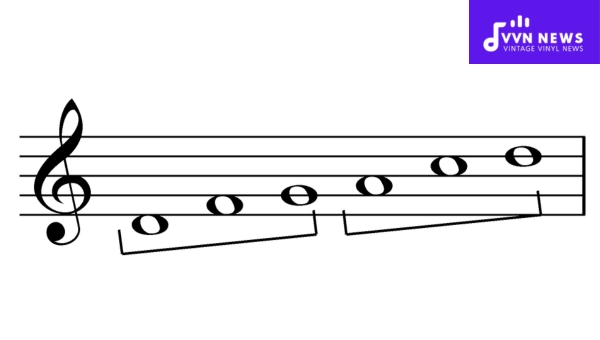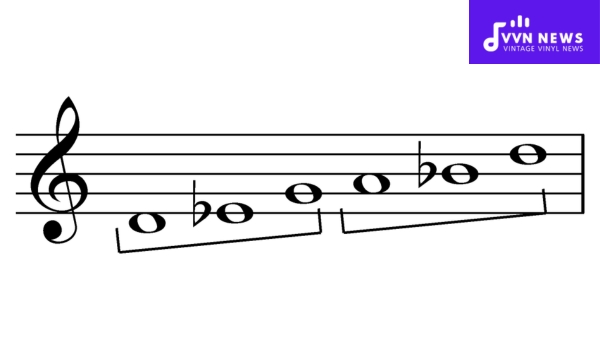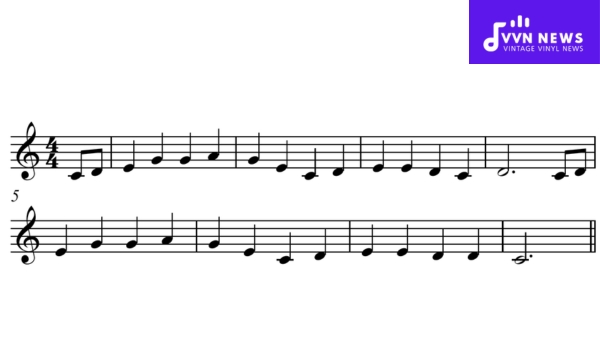When it comes to the world of music theory, exploring new elements can sometimes feel like solving a complex puzzle. But, don’t worry, that’s where I come in to make things a bit more understandable for you. So, “What are pentatonic scales?” you may ask. Well, let’s get right into it!
Pentatonic scales are often the secret sauce in many popular music genres like rock, blues, pop, and even jazz! Loosely defined, a pentatonic scale is essentially a musical scale with five notes per octave, contrasting with the seven-note scales most of us are familiar with.
But there’s much more to learn about these compelling elements of sound than their simple definition – let’s explore further!
What Are Pentatonic Scales?
A pentatonic scale refers to a musical scale that consists of five notes every octave, in contrast to the heptatonic, or seven-note scales prevalent in Western music.
There are two types of pentatonic scales: major and minor. The major pentatonic scale observes the pattern: root note, major 2nd, major 3rd, perfect 5th, and major 6th.
On the other hand, the minor pentatonic scale is characterized by: root note, minor 3rd, perfect 4th, perfect 5th, and minor 7th. Each type has its unique tone and vibe – quintessential elements for many beloved tunes globally!
Also Read: Phrygian Mode [Adding Exotic Flair To Your Musical Compositions]
How Do Pentatonic Scales Differ from Other Musical Scales?
The world of music is rich and diverse, with various elements adding their unique touch.

When it comes to the musical scale, it’s no different. Pentatonic scales, despite their simplicity, bear quite a few striking differences compared to other types of scales.
Below are significant points demonstrating these differences.
1. Number of Tones
Probably the most apparent distinction when comparing pentatonic scales to other musical scales is the number of tones each contains within an octave.
Traditional ‘major’ or ‘minor’ scales contain seven distinct tones before returning to the root note. On the contrary, pentatonic scales comprise only five unique tones per octave – hence the prefix “penta-.”
2. Absence of Semitones
In contrast to diatonic (seven-note) scales and chromatic (twelve-note) scales where semitones are quite common, pentatonic scales completely lack semitones.
This absence makes it far less likely for any two notes played together from this scale to create unwanted dissonance.
3. Ambiguity
A fascinating attribute regarding the pentatonic scale is its inherent ambiguity compared to other musical scales. Most common musical scales own a clear and definitive ‘home’, in other words: Major sounds happy, and Minor sounds sad.
On the flip side, the pentatonic scale doesn’t adhere strictly to either category, often providing an airy or ethereal mood in melodies.
4. Simplicity
Another dissimilarity between pentatonic and other various musical scales lies in their complexity level – or the case of the former – simplicity level! The management and execution of pentatonic tunes are typically simpler due to their lower notes structure.
5. Global Prevalence
Pentatonic’s widespread presence sets it apart from other musical scales. It’s a universal language of music, employed in multiple forms all across the globe – from Afro-American blues, through Celtic folk tunes to traditional East Asian music.
This universal music theory principle marks a clear variance between pentatonic scales and other musical scales. Pentatonic scales with their unique characteristics, offer a diverse perspective on how our favorite tunes can be generated and understood.
By getting acquainted with them, we can widen our musical horizons significantly.
Also Read: C Minor Triad [Simplify Music Composition With This Guide]
Why Are Pentatonic Scales Important in Music?
One of the fundamental reasons why pentatonic scales hold such a prominent place in music lies in their ubiquitous use across different cultures and genres.
Everything from the most primal indigenous music to some of the most sophisticated jazz and blues sounds is essentially woven around pentatonic scales. Now, let’s have a detailed look at this.
Simplicity
Pentatonic scales are marked by their simplicity. They consist of just five notes, an aspect that makes them less complex than the seven-note diatonic scale or “heptatonic.”
Hence, even without much formal training in music, it is relatively easy for one to play melodies or improvise using a pentatonic scale.
Versatility
In terms of versatility, there’s no doubting the value pentatonic scales bring to the table.
These scales serve as invaluable tools for musicians looking to create memorable riffs, solos, or melodies.
Whether it’s Jimi Hendrix’s riff in ‘Purple Haze’ or Louis Armstrong’s jazz improvisations – they’ve all effectively used this scale.
Universality and Cross-cultural Commonality
Pentatonic scales enjoy a sense of universality across the globe. From East Asian traditional pieces to Irish folk songs and African tribal chants – these are instances where musicians have extensively utilized pentatonic scales.
As we can see, pentatonic scales possess the unique ability to cross boundaries of style and geography like no other scale.
This impartiality they show toward harmony allows for seamless transpositions (shifting notes up or down), which further amplifies this universal appeal!
Also Read: F Sharp Minor Pentatonic Scale [How To Use In Your Compositions]
How to Play Pentatonic Scales on Various Instruments?
Putting the pentatonic scale into practice across multiple instruments provides an enriching musical experience.

Whether you’re a master of the keyboard, a virtuoso with the guitar, or simply love the melodious notes on a flute, pentatonic scales can elevate your musical prowess.
Playing Pentatonic Scales on Keyboard
Breaking down the steps to play a pentatonic scale on the keyboard, you’d follow these guidelines:
- Start with identifying your C note.
- From there, play the notes—C, D, E, G, and A. These constitute the C Major Pentatonic Scale.
- To play an F Major Pentatonic Scale, for instance, press F, G, A, C, and D.
It’s fascinating to explore how five-note sequences unlock diverse melodies!
Pentatonic Scales on the Guitar
Appearing complex at first glance is none other than playing pentatonic scales on guitars.
Committing to practicing certain steps will help you master it in no time.
- The Minor Pentatonic Scale (five-pattern system) represents one of the simplest guitar scales and serves as an excellent starting point.
- The first pattern starts at fret 5 – A minor.
- Over time mastering these pattern shifts permits smooth transitions across different parts of the neck.
Remember consistency is key for success here!
Utilizing Pentatonic Scales on Saxophone
Saxophone players make use of pentatonic scales extensively in solos or improvisations and do better grapple with their dynamic range.
One strategy includes:
- Study your five-note placements within music pieces and note it down separately for reference.
- Improve your finger placements gradually to increase speed.
- Subsequently, practice new notes with different key signatures.
In essence, annually adopting this holistic approach will turn you into a pro sooner than expected.
Each instrument carries its unique learning curve and style when it comes to pentatonic scales.
Also Read: C Minor Triad [Simplify Music Composition With This Guide]
What Are Some Famous Songs Using Pentatonic Scales?
Surprisingly, pentatonic scales are far from being a mystery in the popular music scene.
Classic rock, pop ballads, folk tunes, and even dance anthems use this five-note wonder to create compelling melodies.
Let’s delve into some notable uses of pentatonic scales throughout music history.
Rock and Blues
The interpretation of the pentatonic scale in rock and blues genres is particularly fascinating. Iconic songs like “Black Dog” by Led Zeppelin exemplify the use of it.
This track predominantly involves the E minor pentatonic scale and showcases Zeppelin’s trademark style.
Pop Music
Venturing into the domain of pop music, a song that beautifully incorporates these scales is Katy Perry’s chart-topping hit “Firework”.
A great deal of this melodious track employs an A-flat major pentatonic scale.
Folk Tunes
In the realm of traditional tunes, folk music often utilizes these scales to create its unique melodic flavor.
Simple yet powerful songs like “Amazing Grace” use exclusively the notes from a major pentatonic scale which makes for beautiful and timeless melodies.
Jazz
Don’t think we’ve forgotten about jazz! Countless jazz artists, like Miles Davis, have also extensively used pentatonic scales in their works. “Freddie Freeloader” a classic jazz composition is one such example.
There’s no shortage of fabulous songs that owe their irresistible grooves to the magic of pentatonic scales!
Also Read: A Guide Transposing Into The Alto C [Navigate Music Transposition]
FAQs
What exactly is a pentatonic scale?
A pentatonic scale is a musical scale or mode with five pitches per octave, as opposed to the more common seven-note or diatonic scales.
Can pentatonic scales be used in any genre of music?
Yes, pentatonic scales are incredibly versatile and used across multiple genres, including rock, blues, folk, jazz, and pop.
Is the pentatonic scale good for beginners to learn?
Absolutely, due to its simplicity and the pleasant harmony it creates, the pentatonic scale is an excellent starting point for novices.
Are there different types of pentatonic scales?
Indeed there are; the two most common types are the major pentatonic and the minor pentatonic.
How do you practice playing pentatonic scales?
The best way to practice is by playing the five notes up and down the scale on your instrument of choice, starting slowly and gradually increasing speed as you grow comfortable.
Also Read: Transposition Chart [A Lifesaver For All Musicians]
Conclusion
The pentatonic scale proves its worth in the ease and adaptability that it offers musicians. Embracing these five-note wonders enhances improvisation and lends a catchiness to melodies that often resonate across cultures.
Whether you’re plucking at guitar strings or crafting solos on a saxophone, pentatonic scales provide a foundational scaffold that supports both learners and seasoned artists alike.








